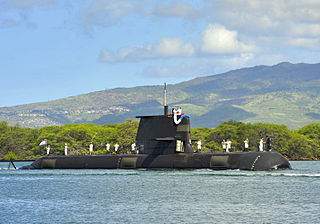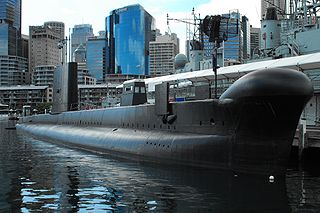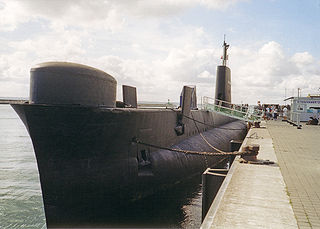
HMAS Quiberon (G81/D20/D281/F03) was a Q-class destroyer of the Royal Australian Navy (RAN). Although built for the Royal Navy and remaining British property until 1950, Quiberon was one of two Q-class destroyers commissioned into the RAN during World War II. She was passed into full RAN ownership in 1950, and converted into an anti-submarine frigate.
HMAS Acute was an Attack-class patrol boat operated by the Royal Australian Navy (RAN).

HMAS Farncomb is the second of six Collins-class submarines operated by the Royal Australian Navy (RAN). Named for Rear Admiral Harold Farncomb, the submarine was laid down in 1993 and launched in December 1995—the first submarine to be completely constructed in Australia. A combination of factors led to Farncomb being the only vessel of her class in operational condition in mid-2009.

HMAS Dechaineux is the fourth of six Collins class submarines operated by the Royal Australian Navy (RAN).

HMAS Sheean is the fifth of six Collins-class submarines operated by the Royal Australian Navy (RAN).

HMAS Onslow is one of six Oberon-class submarines, previously operated by the Royal Australian Navy (RAN). The submarine was named after the town of Onslow, Western Australia, and Sir Alexander Onslow, with the boat's motto and badge derived from Onslow's family heritage. Ordered in 1963, Onslow was laid down at the end of 1967 by Scotts Shipbuilding and Engineering Company in Scotland, launched almost a year later, and commissioned into the RAN at the end of 1969.

HMAS Otama was an Oberon-class submarine, formerly of the Royal Australian Navy (RAN). Built in Scotland, the submarine was the last of the class to enter service when commissioned into the RAN in 1978. Otama was a specialist, one of two "Mystery Boats", fitted with additional surveillance and intelligence-gathering equipment. Otama was routinely deployed on classified operations to obtain intelligence on Soviet Pacific Fleet vessels and Chinese Navy vessels, and conducted associated coastal surveillance, throughout Asia.

HMAS Ovens is an Oberon-class submarine, formerly of the Royal Australian Navy (RAN). She was one of six Oberons built for the Royal Australian Navy by the Scottish Scotts Shipbuilding and Engineering Company, and entered service in 1969. The vessel was named for Irishman and Australian explorer John Ovens (1788–1825) and for whom the Victorian river Ovens was named. During her career, Ovens was the first RAN submarine to deploy with the ANZUK force, and the first RAN submarine to fire an armed Mark 48 torpedo, sinking the target ship Colac. The boat was decommissioned in 1995, and is preserved at the Western Australian Maritime Museum as a museum ship.

The Oberon class was a ship class of 27 British-designed submarines operated by five nations. They were designed as a follow-on from the Porpoise class; physical dimensions were the same but stronger materials were used in hull construction and improved equipment was fitted.

HMAS Hobart was a modified Leander-class light cruiser which served in the Royal Australian Navy (RAN) during World War II. Originally constructed for the Royal Navy as HMS Apollo, the ship entered service in 1936, and was sold to Australia two years later. During the war, Hobart was involved in the evacuation of British Somaliland in 1940, fought at the Battle of the Coral Sea and supported the amphibious landings at Guadalcanal and Tulagi in 1942. She was torpedoed by a Japanese submarine in 1943, then returned to service in 1945 and supported the landings at Tarakan, Wewak, Brunei, and Balikpapan. Hobart was placed in reserve in 1947, but plans to modernise her and return her to service as an aircraft carrier escort, training ship, or guided missile ship were not followed through. The cruiser was sold for scrapping in 1962.

HMAS Vampire was the third of three Australian-built Daring-class destroyers serving in the Royal Australian Navy (RAN). One of the first all-welded ships built in Australia, she was constructed at Cockatoo Island Dockyard between 1952 and 1959, and was commissioned into the RAN a day after completion.

The Australian National Maritime Museum (ANMM) is a federally operated maritime museum in Darling Harbour, Sydney. After considering the idea of establishing a maritime museum, the federal government announced that a national maritime museum would be constructed at Darling Harbour, tied into the New South Wales state government's redevelopment of the area for the Australian bicentenary in 1988. The museum building was designed by Philip Cox, and although an opening date of 1988 was initially set, construction delays, cost overruns, and disagreements between the state and federal governments over funding responsibility pushed the opening to 1991.

The Royal Australian Navy Submarine Service is the submarine element of the Royal Australian Navy. The service currently forms the Navy's Submarine Force Element Group (FEG) and consists of six Collins class submarines.

HMAS Otway was an Oberon-class submarine of the Royal Australian Navy (RAN). One of the first four Oberon-class boats ordered for the RAN, Otway was built in Scotland during the mid-1960s, and commissioned into naval service in 1968. The submarine was decommissioned in 1994. The submarine's upper casing, fin, and stern are preserved at Holbrook, New South Wales.

HMS Otway was an Odin-class submarine of the Royal Australian Navy (RAN) and Royal Navy (RN).

HMS Oxley was an Odin-class submarine of the Royal Australian Navy (RAN) then Royal Navy (RN). Very slightly off course, near Obrestad, on the south-western cape of Norway, she was hit by friendly fire seven days after the start of World War II costing 53 lives and leaving two survivors.

HMAS Oxley was an Oberon class submarine of the Royal Australian Navy (RAN).
HMAS Platypus is a former Royal Australian Navy (RAN) submarine base, located at 118 High Street, North Sydney with moorings in Neutral Bay, a suburb of Sydney in New South Wales, Australia. It was located upon the site of the Royal Australian Navy Torpedo Maintenance Establishment (RANTME), it built on the site of the former North Sydney Gas Works that operated on the site from 1877 and resumed by the Commonwealth in 1942. The Fleet Intermediate Maintenance Activity (FIMA) Workshops building on the site was originally used for torpedo assembly and storage during World War 2. It was later modified for submarine maintenance and repair, with a steel tower added to the northern end of the building for testing, cleaning and maintenance of periscopes.

Rockingham Naval Memorial Park is a military memorial in the City of Rockingham, Western Australia, dedicated to the Royal Australian Navy. It contains a number of commemorative plaques, a 110 mm (4.5 in) gun turret from HMAS Derwent and a submarine fin from HMAS Orion.

















